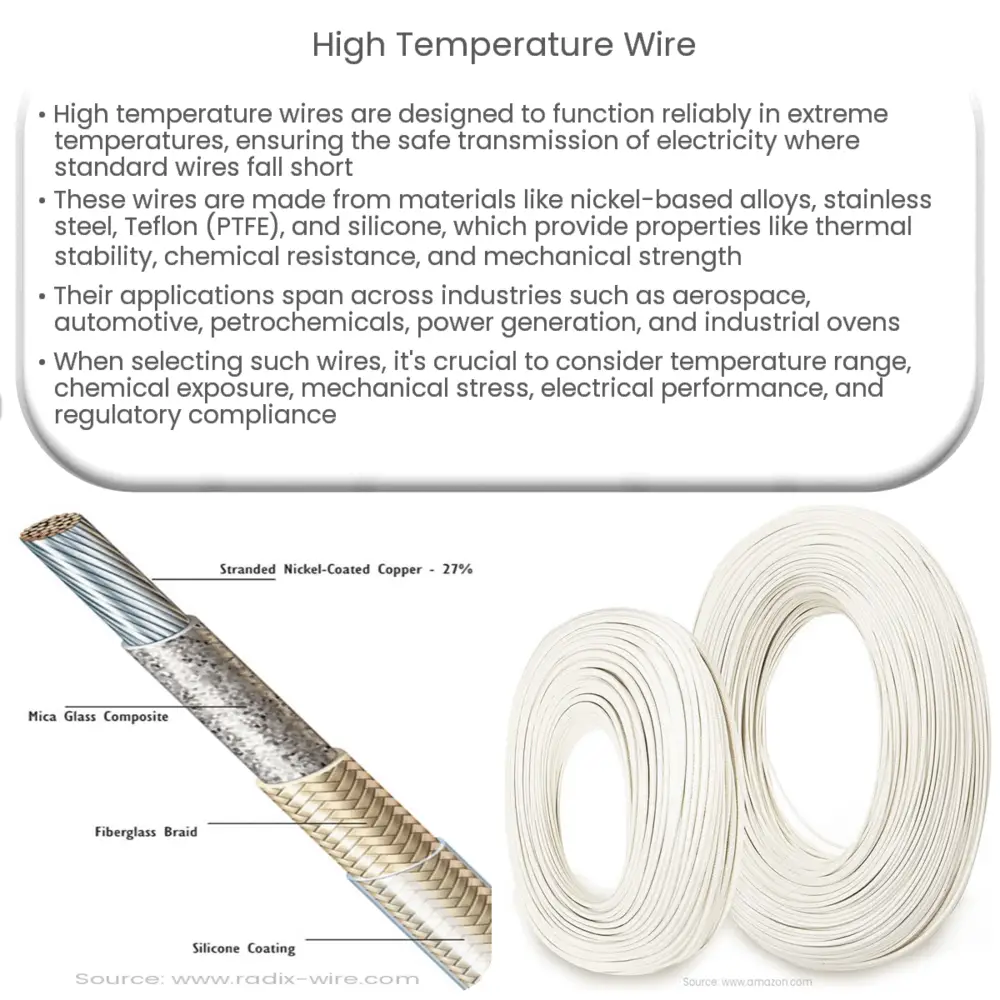High temperature wires ensure safe, efficient electricity transmission in extreme heat conditions, ideal for aerospace, automotive, and industrial applications.

Understanding High Temperature Wire: Properties and Applications
Introduction
High temperature wire, as the name suggests, is designed to withstand extreme temperature conditions. Its primary function is to ensure the safe and efficient transmission of electricity in environments where standard wiring cannot perform reliably. The unique properties of these wires make them suitable for various industrial and commercial applications. In this article, we will delve into the properties of high temperature wire and its various applications.
Materials and Properties
High temperature wires are typically made from materials that can endure extreme heat without compromising their electrical conductivity and structural integrity. Some of the most common materials used in manufacturing high temperature wires include:
- Nickel-based alloys: Nickel-based alloys, such as Inconel, are renowned for their high-temperature resistance and corrosion resistance. These alloys often contain chromium and iron, which further enhance their performance under elevated temperatures.
- Stainless steel: Stainless steel wires, especially those with higher chromium content, are known for their ability to withstand high temperatures. The addition of elements like nickel and molybdenum can further improve their heat resistance.
- Teflon (PTFE): Teflon is a type of synthetic polymer with exceptional heat resistance and chemical inertness. PTFE-insulated wires are ideal for applications that require low friction, high dielectric strength, and resistance to chemical attack.
- Silicone: Silicone-insulated wires offer excellent flexibility and heat resistance. They are commonly used in applications where high flexibility and durability are required, such as in the automotive industry.
High temperature wires exhibit several key properties that make them well-suited for use in extreme temperature conditions. These properties include:
- Thermal stability: High temperature wires can maintain their electrical and mechanical properties at elevated temperatures, which is crucial for ensuring the safe and efficient operation of electrical equipment.
- Chemical resistance: Many high temperature wire materials are resistant to chemicals and corrosive environments, making them suitable for use in industries such as petrochemicals, aerospace, and power generation.
- Electrical performance: Despite the challenging conditions, high temperature wires maintain their electrical conductivity and insulation properties, ensuring reliable power transmission.
- Mechanical strength: High temperature wires can withstand mechanical stress, such as vibrations and tension, without breaking or deforming.
Applications of High Temperature Wire
Due to their unique properties, high temperature wires find applications in a variety of industries and environments where exposure to extreme heat is a concern. Some of these applications include:
- Aerospace: High temperature wires are extensively used in aerospace applications, including aircraft engines, avionics, and spacecraft components, where they must withstand extreme temperature fluctuations and harsh operating conditions.
- Automotive: In the automotive industry, high temperature wires are used in engine compartments, exhaust systems, and various sensors to ensure the safe and reliable operation of vehicles under extreme conditions.
- Petrochemical: Petrochemical plants often require wiring that can endure high temperatures, chemical exposure, and mechanical stress. High temperature wires meet these demands, ensuring the safe operation of equipment and minimizing the risk of accidents.
- Power generation: High temperature wires are used in power plants, including nuclear, coal, and natural gas facilities, to safely transmit electricity and maintain equipment operation in harsh conditions.
- Industrial furnaces and ovens: High temperature wires are essential for the wiring of industrial furnaces, ovens, and kilns, where they must endure extreme temperatures and maintain consistent performance.
Choosing the Right High Temperature Wire
Selecting the appropriate high temperature wire for a specific application is crucial for ensuring safety, performance, and durability. When choosing a high temperature wire, consider the following factors:
- Temperature range: Evaluate the maximum and minimum temperatures that the wire will be exposed to during operation. Make sure to select a wire with a temperature rating that meets or exceeds the requirements of your application.
- Chemical resistance: Consider the chemical environment in which the wire will be used. Choose a wire material that offers resistance to the specific chemicals it may be exposed to.
- Mechanical strength: Determine the level of mechanical stress, such as vibrations and tension, that the wire will be subjected to. Select a wire with sufficient mechanical strength to withstand these stresses.
- Electrical performance: Ensure that the wire’s electrical properties, such as conductivity and insulation, are suitable for the application. This will help maintain reliable power transmission and minimize the risk of electrical failure.
- Regulatory compliance: Verify that the high temperature wire meets relevant industry standards and certifications, such as UL, IEC, and RoHS, to ensure safety and compliance with regulations.
Conclusion
High temperature wires are critical components in various industries and applications where standard wiring cannot withstand extreme temperature conditions. By understanding the properties and applications of high temperature wires and selecting the appropriate wire for your specific needs, you can ensure the safety, efficiency, and reliability of your electrical systems in demanding environments.

